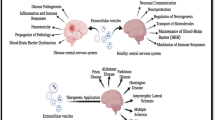Abstract
As a prelude to studying the sodium dependence of choline-transport systems, a number of organic compounds plus LiCl, CsCl and RbCl as sodium substitutes were tested for toxicity to maintain isoosmolality or ionic strength on cultured rat astrocytoma cells. In short term experiments (1 hour), tetramethylammonium chloride, triethanolammonium chloride, guanidinium chloride, tris hydrochloride, mannitol, sucrose, LiCl, RbCl and CsCl were well tolerated. In long term exposure (4 days), no compound was completely nontoxic as a sodium substitute, but sucrose, mannitol, LiCl, and RbCl allowed maximum cell survival.
Similar content being viewed by others
References
Mokrasch LC, Wertz RL, Herbstreith M, Roses AD: Vesicles with transport capability isolated from cultured fibroblasts. Prep Biochem 14: 19–32, 1984
Mokrasch LC: Transport enzymes in the cell membranes of cultured fibroblasts: Alterations in dystrophic cells. Life Sci 37:931–935,1985
Mokrasch LC: Cell membrane transport enzymes in dermal fibroblasts from progeroid donors: A comparison to other human fibroblasts. Gerontol 32: 202–206, 1986
Mokrasch LC: Transport of lysine into cultured rat astrocytes and glioma cells. Neurochem Int 11: 305–311, 1987
McKeehan WL, Ham RL: Stimulation of clonal growth of fibroblasts with substrate coated with basic polymers. J Cell Biol 71:727–734, 1976
Benda P, Lightbody J, Sato G, Levine L, Sweet W: Differentiated rat glial cell strain in tissue culture. Science 161: 370–371,1968
Eagle H: Buffer combinations for mammalian cell culture. Science 174: 500–503, 1971
McKeehan WL, McKeehan KA, Hammond SL, Ham RL: Improved medium for clonal growth of human diploid fibroblasts at low concentrations of serum proteins. In Vitro 13:399–416,1977
Abramowitz M, Stegun I: Handbook of Mathematical Functions. National Bureau of Standards, Washington, DC, 1964
Wold S, Albano C, Dunn WJ, Edlund U, Esbensen K, Geladi P, Hellberg S, Johansson E, Lindberg W, Sjöström M: Multivariate analysis in chemistry, in Kowalski R, (Ed) Chemometrics. Mathematics and Statistics in Chemistry. Reidel Publishing, Dordrecht. 1984, pp 17–95
Mokrasch LC: An efficient scintillation radioassay system and sensitive protein assay for submilligram quantities of subcellular membranes. Anal Biochem 75: 336–339, 1976
Hughes MN: The inorganic chemistry of biological processes. John Wiley and Sons, New York, 1975
Simon JR, Kuhar MJ: High affinity choline uptake: ionic and energy requirements. J Neurochem 27: 93–99, 1976
Spector WS: Handbook of Toxicology. Saunders, Philadelphia. 1956, Vol l, pp 262–263
Cochran KW, Doull J, Mazur M, duBois KP: Acute toxicity of zirconium, columbium, strontium, lanthanum, cesium, tantalium, and yttrium. Arch Ind Hyg Occup Med 1: 637–650, 1950
Burn JH, Dale HH: The action of certain quaternary ammonium bases. J Pharm Exp Ther 4: 417–438, 1915
Melchior NC: Sodium and potassium complexes of adenosine triphosphate. J Biol Chem 208: 615–627, 1954
Author information
Authors and Affiliations
Rights and permissions
About this article
Cite this article
Mokrasch, L.C. Organic cations substituted for sodium are toxic to cultured rat glioma cells. Mol Cell Biochem 92, 85–89 (1990). https://doi.org/10.1007/BF00220723
Received:
Accepted:
Issue Date:
DOI: https://doi.org/10.1007/BF00220723




